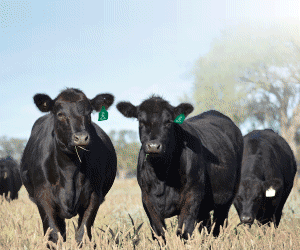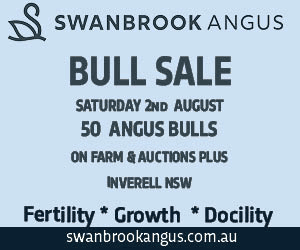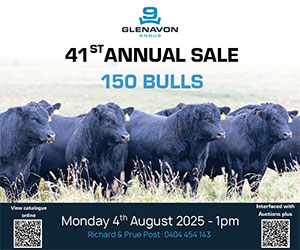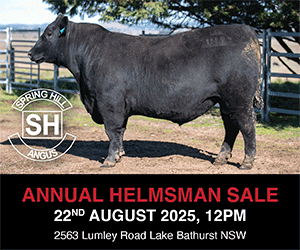Collecting Net Feed Intake Information
Net feed intake information is used to calculate the Net Feed Intake (Feedlot) EBV within the TransTasman Angus Cattle Evaluation (TACE).
Recording Net Feed Intake Information
Collection of net feed intake information can be conducted either ‘on-farm’, or at a ‘central-test’ facility (e.g. Tullimba Research Feedlot), and involves:
- Collection of daily feed intake measurements
- Collection of regular weights to assess the weight, and rate of weight gain of animals
The use of commercial feeding systems that automatically record feed intake of individually electronically identified animals is recommended. Currently most feed intake data is collected using GrowSafe feeding systems, however there are other collection systems such as the Calan Broadbent Feeding System that can effectively capture feed intake data.
How Much Effort is Involved?
Those who are considering collecting net feed intake information for TACE need to be aware that the collection of feed intake measurements must be collected in a standardised way, and can be challenging, expensive, and time consuming.
However, if effective net feed intake information can be collected and analysed through TACE, the benefits can be considerable.
What Animals Should Be Tested?
- Animals must be between 210 and 700 days of age at the commencement of the net feed intake test period
- Bulls, steers or heifers can be tested, however only animals of the same sex should be tested in the same pen.
- All animals should have comprehensive health treatments (e.g. 5 in 1 vaccine, internal and external parasite drench, Bovilis MH + IBR vaccine) prior to entering the test so that they have reduced risk of ill-health, have the ability to achieve their potential growth and feed intake performance, and are assessed on an equal basis.
- The animal identification system adopted must be appropriate for the feeding system used, and must be adequate to allow individual animal feed intake to be recorded. Commercially available automatic feeding systems (e.g. GrowSafe) require the use of a compatible electronic animal identification system such as NLIS tags. The electronic identification numbers must be cross referenced with the Angus Australia ident, and the Angus Australia ident specified when submitting the net feed intake measurements to Angus Australia.
- A minimum adjustment period of 21 days is recommended prior to commencement of the test to allow animals to adjust to the ration and the testing environment/equipment. This can be a combination of a ration in open bunks and then a ration in the feed intake facility. Assessments should be made during the adjustment period to monitor individual feed intakes and acceptance of the diet. If shy feeders are detected during this phase, it is recommended that they be separated from the rest of the group during the pre-test adjustment period. Shy feeders or poor performers may have to be excluded before the feed intake test commences.
- Feed intake measurements should be recorded for each individual animal each day (as kilograms of feed consumed).
- Daily feed intake measurements should be collected for a minimum test period of 70 days, with a minimum of 60 valid feed intake days per animal.
- Animals must be fed a constant ration, fed ad libitum during the test period.
- The ration used must consist of a minimum of 10.0 MJ metabolisable energy (ME) per kg dry matter (DM), and a minimum of 14% crude protein (CP) per kg dry matter (DM). Minimum levels for ME and CP ensure that potential growth rates are not restricted. It is recommended that a ration as close to 12 MJ/kg DM as possible is used when collecting feed intake measurements for NFI-F EBVs.
- During the test period, it is strongly recommended that individual animal performance be monitored by way of regular checks (e.g. review of daily intake measurements and visual assessment). Sick animals may have to be removed from the test.
- Equipment should be carefully monitored during the test period to ensure that faulty equipment (feeding units, scales or identification systems) can be detected in time to allow repairs before data is lost and the test is invalidated.
It is essential that animals are weighed regularly during the feed intake test period as net feed intake is calculated by adjusting daily feed intake for an animal’s live weight and rate of weight gain across the duration of the test.
Each animal must be weighed at the start and end of the test period, and at 14 day intervals during the test period.
All animals in a pen should be weighed as the one group, with animals weighed as promptly as possible after removal from the pen.
There should not be any delay in weighing due to other procedures being conducted (e.g. ultrasound scanning). If other procedures are to be conducted, all animals in a pen should be weighed, and then animals run through a second time for the completion of the other procedure.
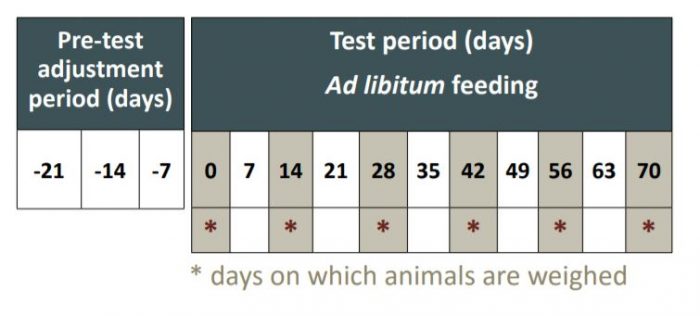
When collating net feed intake information for submission to Angus Australia, the following information needs to be recorded for each animal:
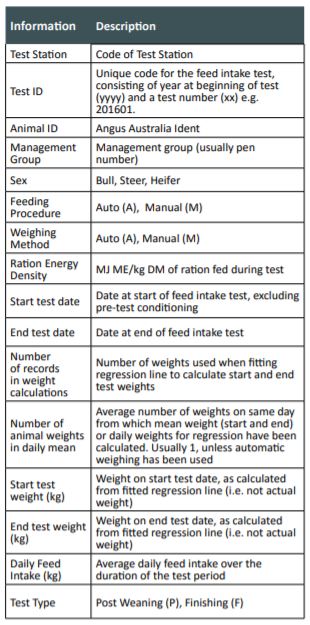
Having collected daily feed intake measurements for each animal during the test period, the average daily intake across the duration of the test needs to be calculated.
It is essential that only valid daily feed intake measurements are included in the calculation of average daily intake. That is, invalid feed intake records should be removed.
A feed intake measurement may be identified as being invalid on a particular day (for either a single animal, a single pen or across all pens) in the trial if:
- an animal becomes sick. Feed intake measurements should not be submitted if the sickness extends for more than 5 consecutive days.
- an animal loses the electronic ear tag and/or cannot be identified. • a pen is out of feed for an extended period (i.e. not ad libitum).
- there is loss of power or faulty equipment in a pen or in the whole system
If there are too many invalid records for an animal, a pen or across all pens, the test period may need to be extended to ensure a minimum of 60 valid daily feed intake measurements for each individual animal, or alternatively, the feed intake measurements should be excluded for any individual animal with less than 60 valid measurements.
The start and end test weights that need to be submitted to Angus Australia for each animal ARE NOT the actual weights recorded at the start and end of the test period, but rather need to be calculated by fitting a linear regression line across all weights collected for an individual animal during the test period. Fitting a regression line enables the animal’s weight and rate of weight gain across the entire duration of the test to be measured more accurately.
When fitting the regression line, it is important that the relationship between the different weights that have been taken on each individual animal is carefully
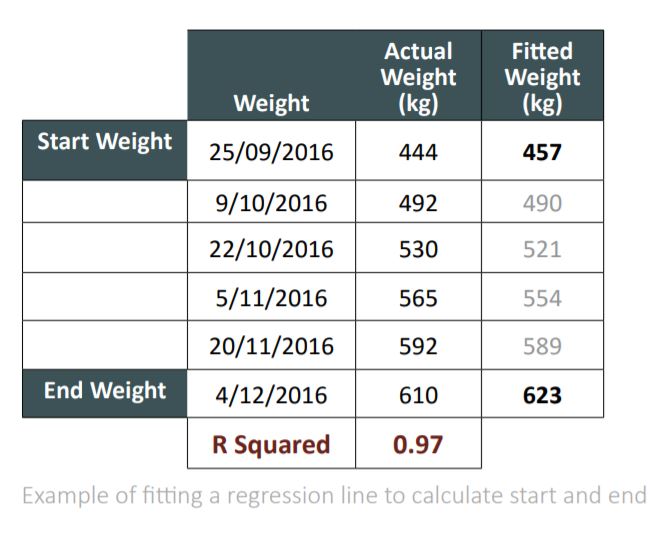
scrutinised, and any weights that are clearly incorrect (i.e. vary considerably from the regression line) excluded from the linear regression calculation. A minimum of 5 weights should be used when fitting the regression line.
A simple way of analysing the relationship between the different weights is the R squared value. Start and end weights should not be submitted for animals if the R squared value is not 0.9 or above.
A spreadsheet that can be used to fit the linear regression line, calculate the start and end test weights, and calculate the R squared value is available from the TACE section of the Angus Australia website.
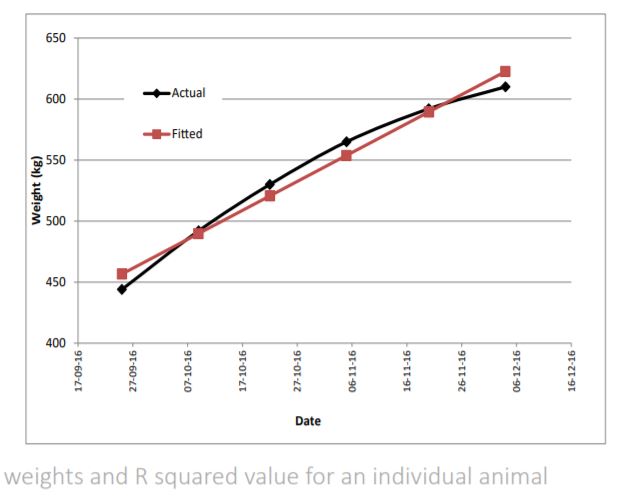
Specifying the Test Station
Standard codes should be specified to identify the test station in which the net feed intake information has been collected.
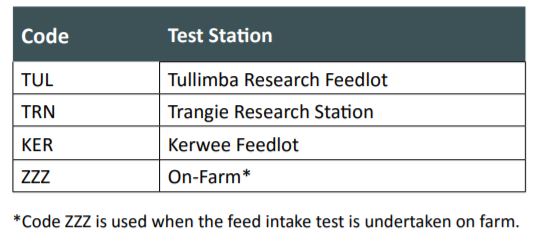
Specifying Management Groups
A management group should be specified to identify any animals within a contemporary group whose net feed intake information (i.e. average daily feed intake / weights) may have been affected by considerable nongenetic factors.
Specifically, a different management group should be specified for animals in different pens, and pen differences will generally have an effect on feed intake
performance. This is particularly important for animals that start their feed intake test on the same day in the same location.
Specifying the Test Type
The test type (P = post weaning / F = finishing) is used to determine whether the net feed intake information corresponds to the NFI-F EBV and needs to be specified when submitting net feed intake information.
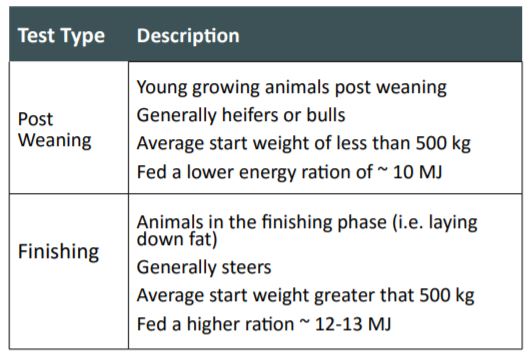
- Animals should be allocated into pens based on their most recent contemporary group within the TACE analysis (e.g. contemporary groups in which the 400 day weights were analysed). In general, this will include animals of the same sex, born in the same herd, born within a 60 day period, and managed under the same conditions prior to net feed intake testing)
- Animals that are in small or single animal contemporary groups prior to the test (e.g. twins, animals that have been sick) should not be tested. The net feed intake information of these animals is of little value.
- For effective sire comparisons, it is recommended to have a minimum of five progeny per sire, and at least two sires represented in each pen.
- The number of animals in each pen should be maximised as it will provide more comparative information per animal.
- If it is necessary to split contemporary groups for the net feed intake test (e.g. due to pen size) then it is important that each sire’s progeny are equally represented in each pen. For example, if a contemporary group of 120 steers needs to be split into 3 pens due to the pen sizes of 40 head, then 1/3 of the progeny by each sire should be randomly selected for each pen.
Click here to print
Angus Australia acknowledges the funds provided by the Australian Government through the Meat & Livestock Australia Donor Company (MDC).
This resource was created as a result of a collaboration between Angus Australia and Meat & Livestock Australia Donor Company (MDC) (Project P.PSH.1063).

